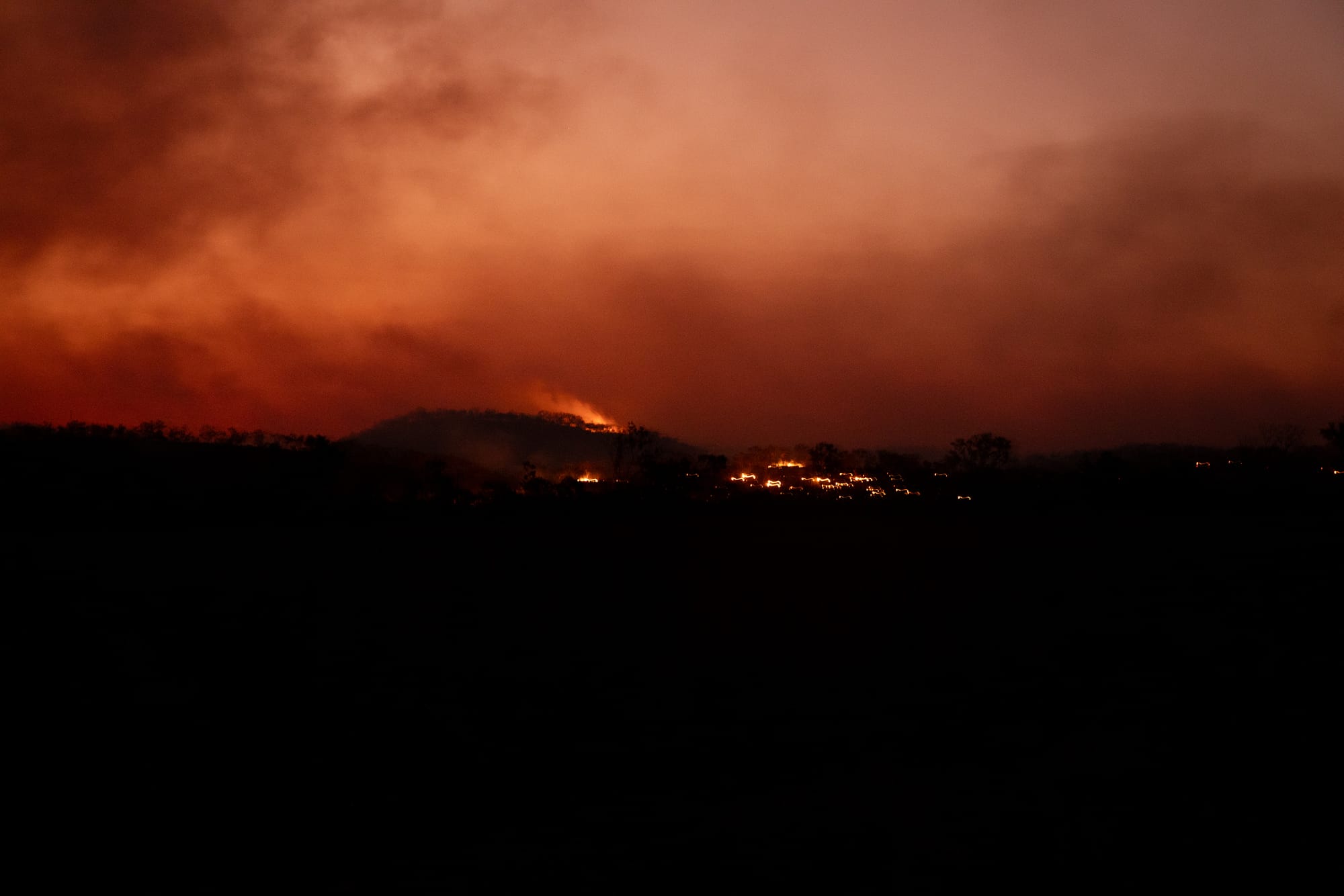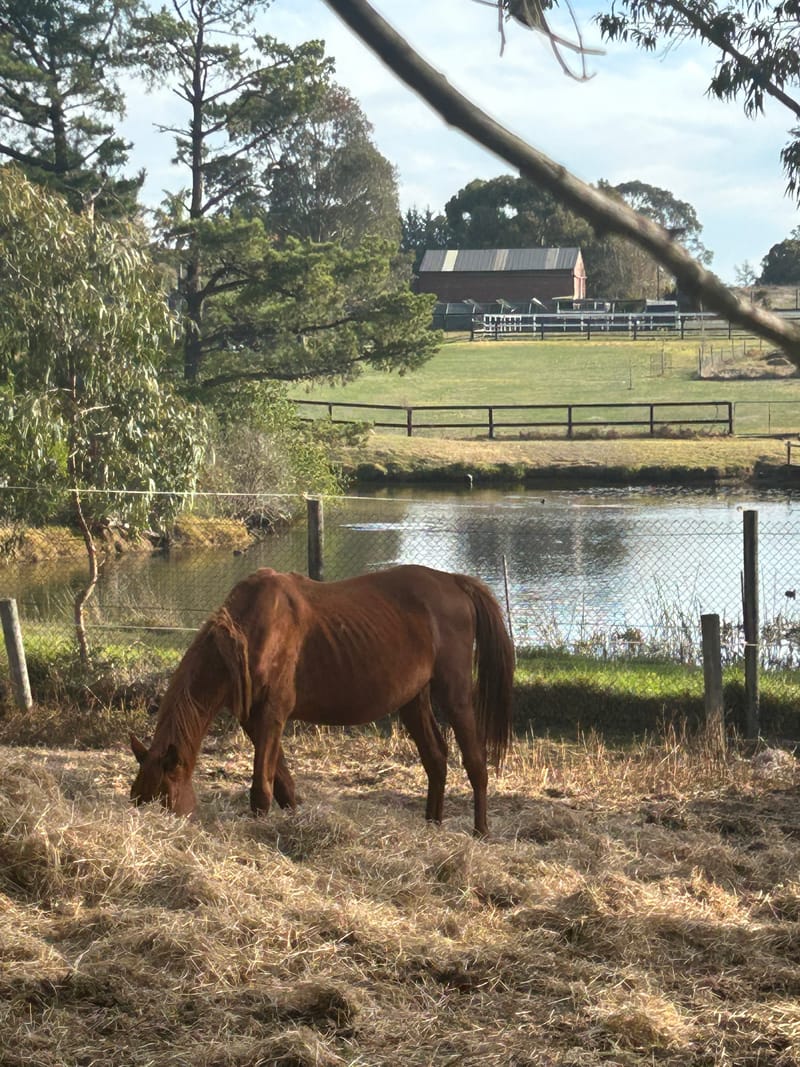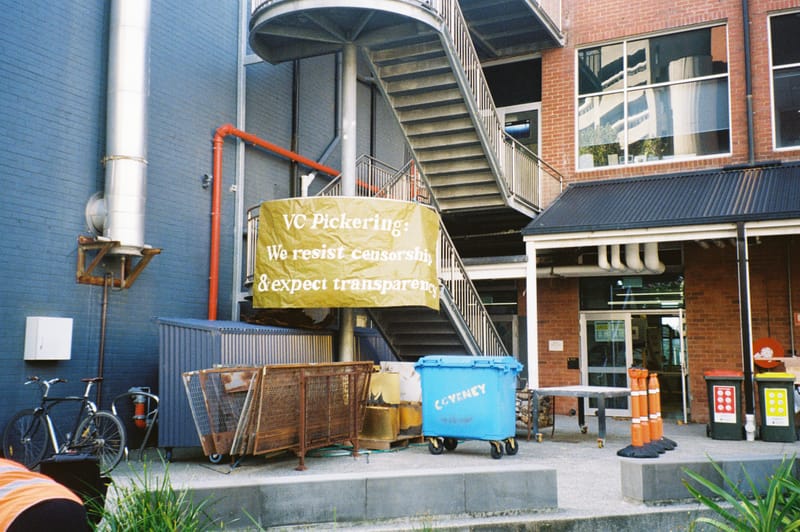What does it mean to manage a Territory aflame?
In the north, fire is both the question and the answer.

BY ESTHER LINDER
Black singed earth lines the Stuart Highway from Alice Springs to Darwin. For hundreds of kilometres, evidence of deliberate and accidental fires tells how the roads of the Northern Territory run fast and burn quick. Here, fire and its usage have shaped the way that humans interact with the land for millennia. It is an increasingly complex relationship in the 21st century.
"Australians just have a very, very poor understanding of the pyroecology of this continent," fire scientist and remarkably calm human Rohan Fisher tells me.
A researcher at Charles Darwin University, based in the territory’s capital, Darwin, Dr Fisher's work focuses on different types of fire and land management, including how Indigenous rangers use fire in culturally and environmentally specific ways.
Anthropological studies show how Aboriginal people have used fire for thousands of years to keep Country and land healthy. In the years since colonisation, this practice has been superseded by white land management policies that focus on agricultural and pastoral interests.
The Top End is subject to the monsoons, with tropical climates meaning fires in the north function vastly differently to those in the southern desert lands. The massive rains and the long dry season mean that northern Australia is one of the most fire-prone regions in the world.
In the southern NT, fewer inhabitants, open grassland, low scrub and more pastoral-held lands feature prominently than across the largely Indigenous homelands of Arnhem Land.
Across its vast distances, on roads where you can drive 130 kilometres an hour, the sheer size and breath of land means that emergency responses function differently to the population centres of south-eastern Australia. Here, where it may be four hours drive between towns, fires burn for months at a time and media often never get to the site of a blaze.
Instead, scientists tell us the stories.
"I mean, I think the NT is reasonably unique: it’s made up of fairly low resourced remote areas," Fisher says.

"So if you're talking about the Northern Territory government for a start, they really don't have much to do with fire and land management across the majority of the territory."
In this state, the Northern Territory Fire and Rescue Service (NTFRS) and emergency services act as the main regulator and responders to fires near to the population hubs of Darwin, Katherine and Alice Springs. Elsewhere, vast tracts of pastoral or traditionally held land are exclusively managed by landholders, Indigenous ranger groups (as in the case of much of Arnhem Land), or not at all.
Bushfires NT works as the main rural emergency communications hub, but much of the actual response, especially when you get further from Darwin or Alice, is down to localised volunteer fire brigades. Ringing around to these patrols is a circular task, with many of them low on resources and not willing to comment.
"The likes of Bushfires NT really have no control or much say really around what happens in terms of fire management across most of the territory," Fisher says. All of its offices are located in urban areas, with 35 staff as of 2020.
"So then you’ve got Parks, which do their best but are not the best resourced parks in the world," Fisher tells me. Parks Australia, the federally run agency responsible for national parks such as Uluru Kata-Tjuta National Park, had operating revenue of $105.9 million in the 2022-2023 financial year.
Parks Australia is by definition national, but has responsibility for some of the most beloved cultural and environmental sites in the NT, including Uluru. This can make for a complex beast.
Fisher describes a fear within Parks Australia that managed burns done in conjunction with Bushfires NT will jump containment lines and turn into uncontrolled blazes. This happened last August, when a fuel reduction burn in the Tjoritja MacDonnell Ranges National Park spiralled out of control. A change in weather conditions whipped up localised backburning into a blaze that covered the Alice Springs township in smoke and shut the Stuart Highway for half a day.
The other two main players in fire management in the NT are not organisations, but individual pastoral landholders and Indigenous-managed lands, such as the Warddeken Indigenous Protected Area (or IPA). Charles Darwin University researchers estimate that pastoral landholdings, largely beef-cattle operations, take up about 46 per cent of the territory’s landmass. The same estimates put conservation areas at 27.5 per cent, with 5 per cent of that national parks (ie. Parks Australia) and the rest IPAs (such as Warddeken).
"The pastoral estate is just a very mixed bag," Fisher says. "It's just full of different characters with completely different ideas about land management and fire management and you get some engaging better than others." What this means in practice is that often land goes unmanaged, and fires run rampant.
As Bushfires NT’s chief fire control officer Tony Fuller said ahead of the proper fire danger period, "80 per cent of the Territory burnt during the 2011-12 season, and due to consecutive La Nina years and above average temperatures forecast this summer, this could repeat again this season". Three months later, as fires raged across land equivalent to the size of Tasmania, he said it was "only just starting to warm up in the centre".
The national council for fire and emergency services, also known as Australasian Fire Authorities Council (or AFAC), released a seasonal bushfire outlook for spring in August of 2023 that was not only dire, but widespread. "Climate influences" were noted as having shifted significantly, with below average rainfall and above average temperatures leading to possibly catastrophic conditions in multiple states.
AFAC chief executive Rob Webb said the climate influences driving increased risk of bushfire that season were widespread.
"Almost the entire country can expect drier and warmer conditions than normal this spring," Webb said.
As of November 1, about 7 million hectares of land had burnt in central Australia between the NT, South Australia and Western Australia, with the wet season still a month away from proper arrival.
Despite the clear and consistent warnings, funding for information services such as Northern Australia and Rangelands Fire Information (or NAFI), to which Fisher contributes, can be scarce.
"I don't think that Northern Territory government really resources their fire management information resources as well as they could," Fisher says, pointing out that NAFI, used by anyone looking to track fire across the continent and a key driver for emergency services to understand need, nearly ran out of funding earlier this year.
"Because the federal government really doesn't understand the importance of good fire — fire as a good land-management activity and the role that it plays across 70 per cent of Australia," he tells me.
"We had the head of the National Emergency Management Agency look at NAFI … He said, 'Oh, what are all these fires across northern Australia?'"
I ask Gareth Catt, a partnerships manager from the Indigenous Desert Alliance (or IDA), if government funding matches the need (and results) for fire management. The answer is no.
"Cultural burning or prescribed burning, generally in Australia, has not been resourced to the level which can have a desirable level of impact across a broad area of landscape," Catt says.
His organisation focuses on supporting Indigenous ranger groups across central Australia, including the Tanami Desert. Fires there have burnt through land twice the area of Tasmania, as little to no policy response emanates from the media departments of the Territory government. Instead, localised responses based on philanthropic donations (as the IDA relies on) are the primary form of land and fire management in the south.
Fire, Fisher says, is "one of the most important human ecological processes that has shaped this continent for the last 60 to 70,000 years". Throughout October, almost every major road and highway in the NT was impacted by smoke or fire risks, leading to delays. Further out, the Tanami Desert is still smoking.





